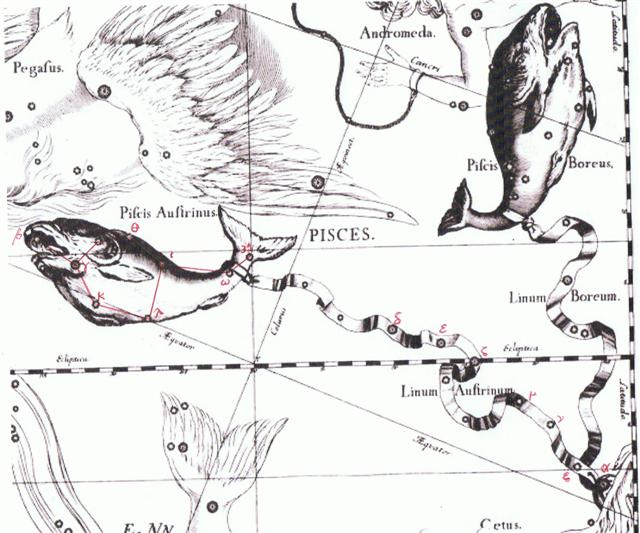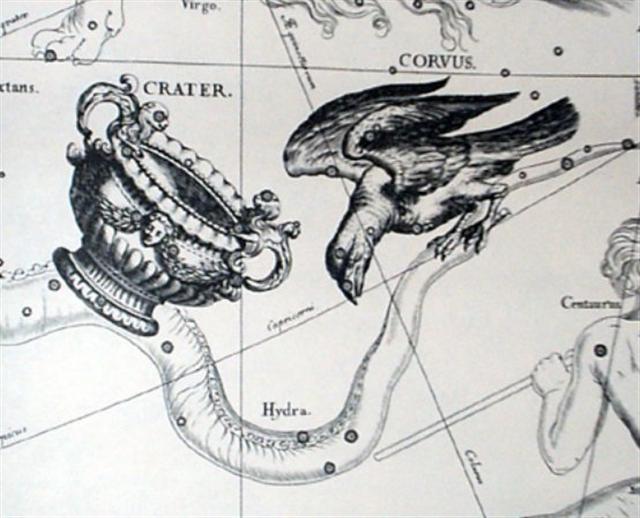A fishy type of manu kake followed 44 days later and 172 (midsummer) + 44 = 216 (= 6 * 36 = 8 * 27). However, the date at manu kake in Ga3-1 was, according to my reading of the text, 'June 26 (177 = 6 * 29½). In Roman times the laws decided by Julius Caesar had spring equinox at 'March 25 = 5 days later than the statistically correct astronomical date for the equinox. This worked out so nicely that day 360 ('December 26 - where 10 * 26 = 260) was close to the Full Moon:
Probably, therefore, manu kake at the star Al Tarf (the End) was intended to illustrate a Janus (door) position, where the previous half year 'bird' was turned around. Either the position was looked at as heliacal (close to the Sun) and then the date was 'June 26 (177) or it was regarded as nakshatra (close to the Full Moon) with 'December 26 (360) as the date. In both cases it was the orbit of the Sun which determined the date. The fishy typ of manu kake which came 44 days later could have been at heliacal day 177 + 44 = 241 ('August 9). But I prefer to count the distance from Al Tarf (*124) to Simmah (*351), because the difference 227 days surely has to mean π (22 / 7). There was an end for the Sun (the Bird) at heliacal Al Tarf and an end for the Moon (the Fish) at nakshatra Simmah. A fish indicates a complementary position compared to a bird, low instead of high. In 'February 8 and close to the Sun was Simmah (γ Piscium) whereas the Full Moon was at β Crateris (Al Sharas) - a dry place where fishes would not thrive.
Beyond the southern of the pair of fishes (Piscis Austrinus) the northern fish was rising ahead like a vaha mea.
In Roman times Simmah rose heliacally 324 days after 0h. This was in 'February 8 (39 = 404 - 365). Al Sharas is a name which sounds as the singular form of Al Sharatain - i.e. Al Sharas could mean 'the Sign:
But Allen offers another name which, I think, could have carried a more profound meaning: "β, of 4.4 magnitude, at the southern edge of the base, was one of Al Tizini's Al Sharāsīf, the Ribs, - i.e. of the Hydra, - and the first of the set."
"The London Missionary John Williams, who put the first native evangelists ashore on Rarotonga in 1823, describes with a perfectly straight face overhearing one of his sailors, Faaori, answer questions from the Rarotongans about the First Man, who he said was Adam: 'The people affirmed that it was Tiki. Faaori then asked them who was the first woman? They answered, Tiki's wife. He inquired of them where she had come from? To this question they could give no answer. He then told them the first woman's name was Eve, and that she was a rib taken out of the first man that Jehovah made ... This was all new to them, and they listened with intense interest to his statements - many exclaiming 'Perhaps this is the truth ..." (Antony Alpers, Legends of the South Seas.) In my reconstruction of the Mayan haab there was a Skeleton Tree where summer ended:
... My arrangement has 15 Moan as the first month of 'winter', i.e. the time of the year corresponding to when sun has gone down in the west in the evening. The mouth which opened wide in spring (cfr 4 Zotz) to allow Sun to enter (in 5 Tzek) has closed again in 15 Moan to show that darkness has returned. The outside 3 black dots in 16 Pax are much greater than those in 9 Ch'en. Darkness falls first with the onset of the rain clouds (the grapelike hanging formation) and then when Sun leaves in autumn. 15 Moan is my candidate for an owl. However, Gates is of the opinion that it is a falcon: 'Six glyphs at least are clearly pictographic in base: Pop, mat; Sotz, bat; Xul, ?; Kankin, skeleton ribs; Moan, falcon; Kayab, turtle.' (Gates) The 'skeleton ribs' in 14 Kankin should be regarded as a version of the 'Tree', I guess ... We can now guess why the henua type of sign has meanings incorporating such diverse ideas as earth and wood. Adam was created from earth, we know, because that was the meaning of his name, and he grew up to become like an Oak. The cycle of Jupiter was 399 days and counting backwards from 'February 8 (404) - when β Crateris (Simmah) was at the Sun - there was a difference of 5 days (corresponding for instance to the difference between 365 and 360 days).
The birth of a new little one occurred on the upraised reef among the fresh water pools: ... There is a couple residing in one place named Kui and Fakataka. After the couple stay together for a while Fakataka is pregnant. So they go away because they wish to go to another place - they go. The canoe goes and goes, the wind roars, the sea churns, the canoe sinks. Kui expires while Fakataka swims. Fakataka swims and swims, reaching another land. She goes there and stays on the upraised reef in the freshwater pools on the reef, and there delivers her child, a boy child. She gives him the name Taetagaloa. When the baby is born a golden plover flies over and alights upon the reef. (Kua fanau lā te pepe kae lele mai te tuli oi tū mai i te papa). And so the woman thus names various parts of the child beginning with the name 'the plover' (tuli): neck (tuliulu), elbow (tulilima), knee (tulivae) ... The Roman as coin has birth as motive on its front side, illustrated by the female part of the ancient ship, with Janus at its complementary side. The upraised reef corresponded to spring and also to the upraised wooden construction on Argo Navis, above which the 'golden plover' hovered - the descending spirit of the expired man - aiming for the first breath (opening of the mouth) of the new baby boy.
|
|||||||||||||||||||||||||||||||||||||||||||||||||||||||||||||||||||||||||||||||||||||||||||||||||||||||||||||||||||||||||||||||||||||||||||||||||||||||||||||||||||||||||||||||||||||||||||||||||||||||||||||||||||||||||





























